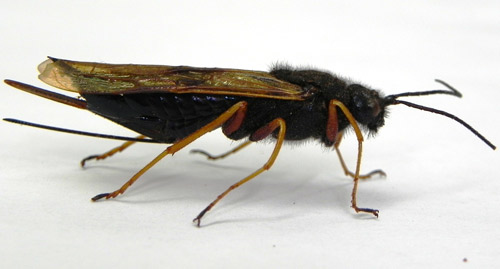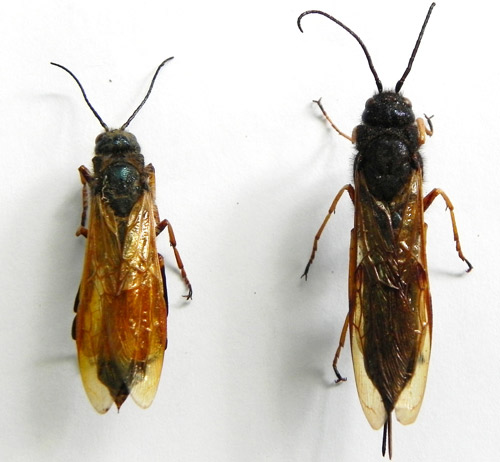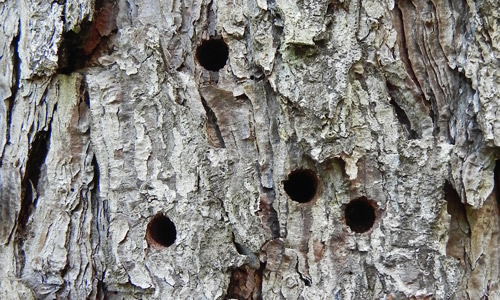common name: sirex woodwasp
scientific name: Sirex noctilio Fabricius (Hymenoptera: Siricidae)
Introduction - Distribution - Description - Biology - Hosts - Damage - Management - Selected References
Introduction (Back to Top)
Sirex noctilio Fabricius (Hymenoptera: Siricidae) is a major forestry pest in Pinus plantations in the Southern Hemisphere and has been detected in native pine trees in North America (Hoebecke et al. 2005, Hurley et al., 2007) (Figure 1). Although populations have not reached outbreak levels, it has quickly become the most abundant woodwasp colonizing pine in northeastern North America (Foelker et al. 2016). Moreover, it is unknown how this insect will behave in western and southern pine forests, as commercial forests in these regions appear highly susceptible to Sirex noctilio establishment (Dodds et al. 2010). Since the woodwasp is spreading more than 30 km every year towards southern pines and warmer weather (Evans 2016), it has the potential to become a pest in Florida. Additionally, pine plantations promote increased abundance of invasive species whose original distributions are associated with woodlands (Lantschner et al. 2013).
Figure 1. Lateral view of Sirex noctilio Fabricius. Photograph by Demian Gomez, University of Florida.
Distribution (Back to Top)
The sirex woodwasp is native to Europe, Asia, and northern Africa, where it is not considered a pest. However, it has caused damage to live trees in the Southern Hemisphere where it has been introduced. It was first introduced in New Zealand (1900), and then in Australia (1951), followed by Uruguay, Argentina, Brazil, South Africa, and Chile. In 2004, one individual was recorded in northern New York State. Subsequently it has spread into the northeastern and midwestern United States (Connecticut, Michigan, New Jersey, New York, Ohio, Pennsylvania, and Vermont) and southeastern Canada (Ayres et al. 2014, Hoebecke et al. 2005, Pest tracker 2016).
Description (Back to Top)
All woodwasps, also known as horntails, belong to the family Siricidae (Hymenoptera: Symphyta). The Symphyta can be easily distinguished from other wasps by the absence of a constriction between the thorax and the abdomen. Woodwasps are large, robust insects, usually 2.5 to 4 cm long. Adults have a spike-like projection at the tail end and females have a long ovipositor under this projection. Larvae are white, legless, and have a distinctive dark spine at the end of the abdomen.
The genus Sirex can be distinguished from other siricids by the dark blue or green metallic reflections of the dark sections of body, the antennal flagellum with 12 or more segments, the metatibia with two apical spurs, and the forewing rounded at the tip.
Specimens of Sirex noctilio are recognized by the black body and the entirely black antennae (Figure 2). Most specimens of Sirex noctilio have light reddish-brown femora and clear wings. However, some specimens recorded from southern Europe have black femora and tinted wings in females (Schiff et al. 2012). Females are recognized by the dark metallic blue body, the large median pits on the lancet of the ovipositor (pit 0.5–0.75× the length of the annulus) and the short tarsal pads (tarsal pad of metatarsomere 2 is 0.2–0.4× the length of the ventral length of tarsomere 2). Males are recognized by the wide reddish-brown base of the metatibia. The forewing is light yellowish-brown. The abdomen is black on segments 1–2 and on segment 8, and yellowish-brown in the middle.
Five native woodwasps have been recorded in Florida but only two belong to the genus Sirex (Leavengood et al. 2013). Sirex areolatus is distinguished by the ovipositor being longer than the width of the forewing in females and the entirely black legs and translucent wings in males. Sirex nigricornis is distinguished by the red abdomen.
Figure 2. Dorsal view of Sirex noctilio Fabricius (male left, female right). Photograph by Demian Gomez, University of Florida.
Biology (Back to Top)
Sirex noctilio usually completes one generation per year but may require two years in colder temperatures (Lombardero et al. 2016). Adults emerge in late summer and live only one to two weeks and do not feed (Hoebeke et al. 2005). After seeking a mate, females insert their ovipositor through the bark and into the sapwood, leaving a characteristic resin drip. They are attracted to physiologically stressed pines, as healthier trees with high moisture content tend to be rejected by Sirex species (Talbot et al. 1977). Females generally deposit one to three eggs but they can lay 500 eggs during their lifetime. They can also do single drills, where eggs are rarely laid if they judge the tree to be unsuitable. During oviposition or single drills, they introduce a toxic venom and spores of the symbiotic fungus Amylostereum areolatum. This fungus benefits from its association with Sirex by being dispersed and placed in the wood of a suitable host without having to penetrate any protective tissues and is the main nutritional source for larvae while tunneling through the wood. Adults emerge through round exit holes, which are between 3 to 7 mm in diameter (Figure 3). The emergence holes vary in size due to variability in Sirex body size and provide a good diagnostic characteristic when trying to distinguish emergence holes from those made by other insects. Before leaving the tree host, adult females acquire spores of the mutualistic fungus in their mycangia (pockets in the exoskeleton) (Hoebeke et al. 2005).
Interactions between Sirex noctilio and the bark beetle Ips grandicollis have been documented recently (Foelker 2016). Ips grandicollis infestation is responsible for the reduction in emergence, size and parasitism of Sirex noctilio directly by causing reduction in tree moisture content and indirectly by vectoring the fungus Ophiostoma ips, which is known to competitively exclude Amylostereum areolatum (Yousuf et al. 2014).
Figure 3. Exit holes in of Sirex noctilio Fabricius in Pinus taeda. Photograph by Demian Gomez, University of Florida.
Hosts (Back to Top)
Sirex noctilio develops primarily in Pinus spp., but very occasionally, it can also be found in species from the genus Abies, Larix, Picea, and Pseudotsuga (Hoebeke et al. 2005). Pinus species that it has been recorded from include: Pinus banksiana, Pinus caribaea, Pinus contorta, Pinus echinata, Pinus elliottii, Pinus jeffreyi, Pinus kesiya, Pinus nigra, Pinus palustris, Pinus patula, Pinus pinaster, Pinus pinea, Pinus radiata, Pinus resinosa, Pinus strobus, Pinus sylvestris, and Pinus taeda. In North America, Sirex noctilio attacks Pinus sylvestris (Scots pine, a non-native species) more than any native pine species (Ayres et al. 2014).
Damage (Back to Top)
The ability to kill the host tree with fungus and venom distinguishes Sirex noctilio from other siricids and is the reason why Sirex noctilio is a major pest of some hosts whereas most other woodwasps are not (Schiff et al. 2012). Sirex noctilio has caused significant economic damage in the Southern Hemisphere (Slippers et al.2015). In the northeastern United States and southern Canada, Sirex noctilio appears to have joined the native scavenger community, utilizing stressed and dead trees as reproductive habitat. In some cases, larger apparently healthy trees were colonized but at a lower frequency than the smaller suppressed trees (Dodds et al. 2010). Sirex noctilio does not appear to be causing excessive tree mortality at this point, and it is difficult to assess its potential for damage in North America.
The history of the global spread of Sirex noctilio reflects a complex pattern of introductions that have occurred multiple times and from numerous different sources (Slippers et al.2015). Despite quarantine systems, Sirex noctilio has continued to spread. Thus, we should expect further introductions and reintroductions of the wasp, including from nonnative back to native areas.
Management (Back to Top)
To reduce the risk of an outbreak, forest managers need to follow an optimum thinning schedule to maintain stand vigor (also used as a managing strategy for the southern pine beetle) and monitor Sirex populations. The use of biological control agents such as parasitic wasps and nematodes are also an effective option (Haugen 1990). Moreover, there are state regulations for firewood movement. The more recent quarantine regulations, as a response to the sirex woodwasp and other wood borers, cite firewood as a regulated item, while some cite “logs” and “branches” of one or multiple species including firewood (Borchert et al. 2011). Several states are developing regulations to restrict the movement of firewood, among other raw wood products.
Besides proper silviculture, the most effective management strategy for Sirex noctilio in the southern hemisphere involves biocontrol with the parasitic nematode Deladenus siricidicola (Nematoda: Beddingidae). The biocontrol program consists of setting up trap trees into which the nematodes are inoculated. The nematode feeds and reproduces on Amylostereum aerolatum and also parasitizes Sirex noctilio larvae (Bedding 1972). Once the metamorphosis of the wasp larva is completed, parasitized adult females are usually sterile, and will lay eggs full of nematodes on new trees, spreading the biocontrol agent. However, there are some important barriers to control with nematodes in the United States. First, Deladenus siricidicola can also colonize native woodwasps in North America and has the potential to threaten native communities. Second, despite the high parasitism rate of adults in the United States, the nematodes do not seem to penetrate the egg and are not capable of sterilizing females here. This might be due to the nematode strain, the biology of Sirex noctilio in the United States, or both (Krivak-Tetley pers. comm.).
Control of Sirex noctilio populations by its natural enemies is another important tool in the southern hemisphere for active management of this pest in invaded non-native pine plantations (Slippers et al. 2015). Numerous parasitic wasp species (Ibalia, Megarhyssa, Rhyssa, and Schlettererius species) have been introduced into Australasia for the biological control of Sirex noctilio. However, these insects remain patchily distributed in other areas of the world and there is some concern about them negatively affecting our native siricid fauna. It is not yet clear whether parasitoids are an effective option in the southeastern US.
Selected References (Back to Top)
- Ayres MP, Pena R, Lombardo JA, Lombardero MJ. 2014. Host use patterns by the European woodwasp, Sirex noctilio, in its native and invaded range. PLoS ONE 9: e90321.
- Bedding RA. 1972. Biology of Deladenus siricidicola (Neotylenchidae), an entomophagous nematode parasitic in siricid woodwasps. Nematologica 18: 482-493.
- Borchert D, Newton L, Culliney T, Hartzog H, Ahern R, Garrett L. 2011. Risk assessment of the movement of firewood within the United States. U.S. Department of Agriculture, Animal and Plant Health Services, Plant Protection and Quarantine, Center for Plant Health Science and Technology, Plant Epidemiology and Risk Analysis Laboratory, Raleigh, NC. (19 September 2019)
- Dodds KJ, de Groot P, Orwig DA. 2010. The impact of Sirex noctilio in Pinus resinosa and Pinus sylvestris stands in New York and Ontario. Canadian Journal of Forest Research 40: 212-223.
- Evans AM. 2016. The speed of invasion: Rates of spread for thirteen exotic forest insects and diseases. Forests 7: 1-11.
- Foelker CJ. 2016. Beneath the bark: Associations among Sirex noctilio development, bluestain fungi, and pine host species in North America. Ecological Entomology doi: 10.1111/een.12342.
- Foelker CJ, Standley CR, Parry D, Fierke MK. 2016. Complex ecological relationships among an assemblage of indigenous hymenopteran parasitoids, the exotic European woodwasp (Sirex noctilio; Hymenoptera: Siricidae), and a native congener. The Canadian Entomologist 148: 532-542.
- Haugen DA. 1990. Control procedures for Sirex noctilio in the Green Triangle: Review from detection to severe outbreak (1977-1987). Australian Forestry 53: 24-32.
- Hoebeke ER, Haugen DA, Haack RA. 2005. Sirex noctilio: Discovery of a Palearctic siricid woodwasp in New York. Newsletter of the Michigan Entomological Society 50: 24-25.
- Hurley BP, Slippers B, Wingfield MJ. 2007. A comparison of control results for the alien invasive woodwasp, Sirex noctilio, in the southern hemisphere. Agricultural and Forest Entomology 9: 159-171.
- Lantschner MV, Rusch V, Hayes JP. 2013. Do exotic pine plantations favour the spread of invasive herbivorous mammals in Patagonia? Austral Ecology 38: 338-345.
- Leavengood JM, Smith T R. 2013. The Siricidae (Hymenoptera: Symphyta) of Florida. Insecta Mundi 309: 1-16.
- Lombardero, MJ, Ayres MP, Krivak-Tetley FE, Fitza KNE. 2016. Population biology of the European woodwasp, Sirex noctilio, in Galicia, Spain. Bulletin of Entomological Research 106: 1-12.
- Pest Tracker. Perdue University. http://pest.ceris.purdue.edu/ (19 September 2019)
- Slippers B, Hurley BP, Wingfield MJ. 2015. Sirex woodwasp: A model for evolving management paradigms of invasive forest pests. Annual Review of Entomology 60: 601-619.
- Talbot PHB. 1977. The Sirex-Amylostereum-Pinus Association. Annual Review of Phytopathology 15: 41-54.


